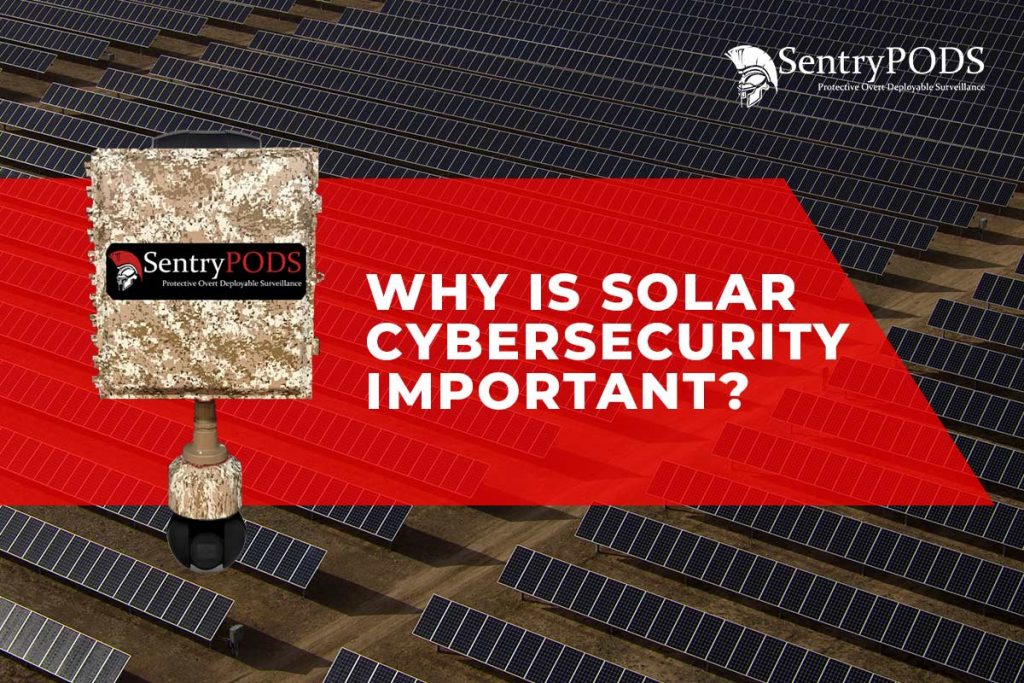Why Is Solar Cybersecurity Important?
 The reliable and safe operation of our nation’s electrical grids is critical for the U.S. economy and national security. In recent years, renewable energy sources like solar power have become increasingly popular with both large and small utility companies across the country. As the amount of solar energy on the grid grows, solar is becoming an integral part of the nation’s energy output. This means that U.S. solar farms need to protect their facilities with increased solar cybersecurity, making them more resistant to widespread disruptions. With that being said, the need for critical infrastructure surveillance continues to grow.
The reliable and safe operation of our nation’s electrical grids is critical for the U.S. economy and national security. In recent years, renewable energy sources like solar power have become increasingly popular with both large and small utility companies across the country. As the amount of solar energy on the grid grows, solar is becoming an integral part of the nation’s energy output. This means that U.S. solar farms need to protect their facilities with increased solar cybersecurity, making them more resistant to widespread disruptions. With that being said, the need for critical infrastructure surveillance continues to grow.
Cybersecurity For Solar Farms
As the electric grid becomes increasingly more digitized and connected, maintaining cybersecurity is a top priority for solar farm operators. However, cybersecurity challenges in this sector are complicated by the large number of owners and operators involved. Adding to the difficulty is the fact that the electric grid is a cyber-physical system, meaning that cyberattacks can cause physical damage and safety issues as well as disrupt the flow of data.
This means that solar systems and facilities need to be more cyber-aware and cyber-secure, with the capabilities to prevent, identify, detect, respond to, and recover from cyberattacks. But how can individual operators achieve this level of solar cybersecurity at their facilities? Adopting these common protections is a good place to start:
- Anti-malware software – routine scanning of all devices with this software will detect threats and remove malicious software.
- Security information and event management (SIEM) – this tool protects your network against malicious software and monitors activity and access across all networks.
- Firewall – this digital barrier between internal systems and the outside world scans, evaluates, and filters incoming traffic, protecting individual computers and networks.
- Trust zones – these firewalls can be installed within your internal network to protect sensitive information requiring additional security.
- Data encryption – by encrypting data on all devices you will protect the devices as well as the data flowing between all networked devices.
- Multi-factor authentication – secure the facility and its networks by requiring your employees to provide more than just a password when entering a sensitive network or system.
Of course, making sure solar system operators are aware of cybersecurity standards and best practices are also key when securing solar facilities. Ongoing training for all staff and contractors on-site is the first step in protecting solar farms as well as the grid these farms supply.
Are Solar Farms Vulnerable To Hackers?
The electric grid is a cyber-physical system. Cyber-physical systems are engineered systems that are built from and depend on the integration of networked computers as well as physical components. In the past, cyber-risk for solar was relatively unheard of, because so few systems were in use and most solar inverters did not communicate with other components for monitoring or control. However, as more solar arrays come online and inverters become more advanced, the risk of cyberattacks has grown. If an inverter’s software isn’t kept updated and secure, its data could be intercepted and manipulated. Hackers could also imbed code into an inverter that could spread malware into the larger power system.
The consequences of a cyberattack if solar cybersecurity is not in place include:
- Loss of production and revenue
- Damage to assets and infrastructure
- Release of sensitive commercial information and damage to operator’s reputation
- Regulatory non-compliance and fines
- Health, safety, and environmental risks
A cyberattack that introduces instabilities or false information into the power system can cause physical as well as financial damage to a solar facility. For example, a security breach could order an unauthorized change in power delivery. Unauthorized changes to inverter controls can result in a change in voltage or electric current that the inverter sends into homes or the grid, and can cause fires or other damage to physical structures. This is why protecting solar farms and facilities from cyberattacks is part of an overall strategy to maintain our nation’s critical electrical infrastructure and promote solar cybersecurity across the sector.
Managing Vulnerabilities To Solar Infrastructure
Security software can help utilities maintain control of their facilities and prevent attackers from inserting false information into their operating systems and networks. Most attempted attacks on the grid are prevented by intrusion-detection software that alerts grid operators to a change in operating behavior. Utilities and solar system owners and operators can use multi-layered methods to protect their assets. Installing anti-virus software for solar inverters and battery controllers is one layer of protection. Using virus protection and detection on the firewalls and servers that are networked into the broader system of grid operation is another layer. By deploying a layered system of defense and working cybersecurity into the daily operations of their facilities, solar operators can greatly reduce the chance of cyberattack and protect the grid.
For more information on Solar Farm Security, visit our critical infrastructure site.

Brent Canfield
CEO and Creator of SentryPODSBrent Canfield, CEO, and founder of Smart Digital and SentryPODS, founded Smart Digital in 2007 after completing a nine-year active-duty career with the United States Marine Corps. During the 2016 election cycle, he provided executive protection for Dr. Ben Carson. He has also authored articles for Security Info Watch.

